Danao, Cebu
| Danao | ||
|---|---|---|
| Component City | ||
| City of Danao | ||
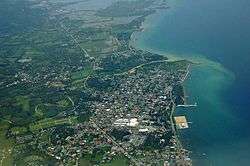 Aerial view of Danao | ||
| ||
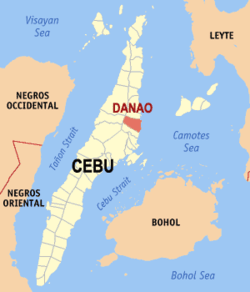 Map of Cebu with Danao highlighted | ||
.svg.png) Danao Location within the Philippines | ||
| Coordinates: 10°32′N 123°56′E / 10.53°N 123.93°ECoordinates: 10°32′N 123°56′E / 10.53°N 123.93°E | ||
| Country |
| |
| Region | Central Visayas (Region VII) | |
| Province | Cebu | |
| District | 5th district of Cebu | |
| Chartered | 1773 | |
| Cityhood | 7 June 1961 | |
| Barangays | 42 (see Barangays) | |
| Government [1] | ||
| • Type | Sangguniang Panlungsod | |
| • Mayor | Nito Durano | |
| • Vice Mayor | Mix Durano | |
| • Congressman | Red Durano | |
| • Electorate | 86,085 voters (2016) | |
| Area [2] | ||
| • Total | 107.30 km2 (41.43 sq mi) | |
| Elevation | 40 m (130 ft) | |
| Population (2015 census)[3] | ||
| • Total | 136,471 | |
| • Density | 1,300/km2 (3,300/sq mi) | |
| Time zone | UTC+8 (PST) | |
| ZIP code | 6004 | |
| PSGC | 072223000 | |
| IDD : area code | +63 (0)32 | |
| Climate type | Tropical climate | |
| Income class | 3rd city income class | |
| Revenue (₱) | 535,357,539.82 (2016) | |
| Native languages |
Cebuano Tagalog | |
| Website |
www | |
Danao, officially the City of Danao, (Cebuano: Dakbayan sa Danao; Tagalog: Lungsod ng Danao), or simply known as Danao City, is a 3rd class city in the province of Cebu, Philippines. According to the 2015 census, it has a population of 136,471 people.[3]
Danao City is bordered on the north by the town of Carmen, to the west by the town of Asturias, southwest by Balamban, and northwest by Tuburan on the east by the Camotes Sea, and on the south by the town of Compostela.
Distance to Carmen, it is 8.20 km. To Balamban (via Toledo City), it is 96.0 km. To Asturias (via Lugo), it is 92.14 km. Distance to Compostela, it is 7.80 km. Danao lies within Metro Cebu area and is approximately 33 km from Cebu City. [4]
History
The area of what is now Danao used to be a part of the Cebuano Kingdom of Nahalin, ruled by Sri Ukob, one of the sons of Sri Lumay, the ruler and founder of the Rajahnate of Cebu, before the conquest of Cebu by the Spanish starting in 1565. In 1570 it became an ecomienda or a farmland controlled by certain Spanish officials, only to be abolished in the 18th century as abuses to the native workers became apparent. In 1609 Danao was made a parish by the Recollects, and much later in 1773 it officially became a municipality.
Much physical changes occurred in Danao as it went and passed through the 20th century. Mining, cement making and gun making industries made the once sleepy town of Danao so prosperous that in 1961 a national charter was passed to convert it into a city.
Barangays
Danao City comprises 42 barangays:
| PSGC | Barangay | Population | ±% p.a. | Area | PD 2015 | |||||
|---|---|---|---|---|---|---|---|---|---|---|
| 2015[3] | 2010[5] | ha | acre | /km2 | /sq mi | |||||
| 072223001 | Baliang | 1.4% | 1,843 | 1,728 | 1.23% | 527 | 1,302 | 350 | 910 | |
| 072223002 | Bayabas | 0.5% | 714 | 609 | 3.07% | 220 | 544 | 320 | 840 | |
| 072223004 | Binaliw | 1.9% | 2,635 | 2,341 | 2.28% | 121 | 299 | 2,200 | 5,600 | |
| 072223006 | Cabungahan | 1.7% | 2,317 | 2,201 | 0.98% | 130 | 321 | 1,800 | 4,600 | |
| 072223007 | Cagat-Lamac | 0.9% | 1,253 | 1,023 | 3.94% | 121 | 299 | 1,000 | 2,700 | |
| 072223008 | Cahumayan | 3.0% | 4,162 | 3,506 | 3.32% | 1,260 | 3,114 | 330 | 860 | |
| 072223009 | Cambanay | 2.6% | 3,526 | 2,818 | 4.36% | 336 | 830 | 1,000 | 2,700 | |
| 072223010 | Cambubho | 0.7% | 940 | 594 | 9.13% | 165 | 408 | 570 | 1,500 | |
| 072223011 | Cogon-Cruz | 3.1% | 4,188 | 3,034 | 6.33% | 281 | 694 | 1,500 | 3,900 | |
| 072223012 | Danasan | 1.0% | 1,350 | 1,266 | 1.23% | 516 | 1,275 | 260 | 680 | |
| 072223013 | Dungga | 0.9% | 1,273 | 1,017 | 4.37% | 256 | 633 | 500 | 1,300 | |
| 072223014 | Dunggoan | 4.6% | 6,310 | 5,313 | 3.33% | 241 | 596 | 2,600 | 6,800 | |
| 072223015 | Guinacot | 3.6% | 4,853 | 4,089 | 3.32% | 300 | 741 | 1,600 | 4,200 | |
| 072223016 | Guinsay | 6.7% | 9,152 | 7,887 | 2.87% | 376 | 929 | 2,400 | 6,300 | |
| 072223017 | Ibo | 0.9% | 1,171 | 964 | 3.77% | 194 | 479 | 600 | 1,600 | |
| 072223018 | Langosig | 0.7% | 1,020 | 750 | 6.03% | 126 | 311 | 810 | 2,100 | |
| 072223019 | Lawaan | 1.2% | 1,679 | 1,352 | 4.21% | 418 | 1,033 | 400 | 1,000 | |
| 072223020 | Licos | 1.4% | 1,852 | 1,581 | 3.06% | 251 | 620 | 740 | 1,900 | |
| 072223021 | Looc | 7.0% | 9,543 | 9,200 | 0.70% | 305 | 754 | 3,100 | 8,100 | |
| 072223022 | Magtagobtob | 0.3% | 453 | 382 | 3.30% | 324 | 801 | 140 | 360 | |
| 072223023 | Malapoc | 0.9% | 1,256 | 974 | 4.96% | 153 | 378 | 820 | 2,100 | |
| 072223024 | Manlayag | 1.2% | 1,638 | 1,578 | 0.71% | 426 | 1,053 | 380 | 1,000 | |
| 072223025 | Mantija | 1.1% | 1,447 | 1,233 | 3.09% | 337 | 833 | 430 | 1,100 | |
| 072223026 | Masaba | 2.3% | 3,090 | 2,743 | 2.29% | 223 | 551 | 1,400 | 3,600 | |
| 072223027 | Maslog | 7.3% | 9,929 | 9,892 | 0.07% | 323 | 798 | 3,100 | 8,000 | |
| 072223028 | Nangka | 0.3% | 413 | 446 | −1.45% | 306 | 756 | 130 | 350 | |
| 072223029 | Oguis | 0.5% | 634 | 600 | 1.06% | 92 | 227 | 690 | 1,800 | |
| 072223030 | Pili | 0.6% | 777 | 677 | 2.66% | 184 | 455 | 420 | 1,100 | |
| 072223031 | Poblacion | 6.7% | 9,090 | 8,710 | 0.82% | 131 | 324 | 6,900 | 18,000 | |
| 072223032 | Quisol | 1.1% | 1,461 | 1,255 | 2.94% | 173 | 428 | 840 | 2,200 | |
| 072223033 | Sabang | 9.1% | 12,431 | 9,945 | 4.34% | 343 | 848 | 3,600 | 9,400 | |
| 072223034 | Sacsac | 0.5% | 618 | 514 | 3.57% | 184 | 455 | 340 | 870 | |
| 072223035 | Sandayong Norte | 1.1% | 1,490 | 1,454 | 0.47% | 71 | 175 | 2,100 | 5,400 | |
| 072223036 | Sandayong Sur | 2.2% | 3,069 | 2,808 | 1.71% | 404 | 998 | 760 | 2,000 | |
| 072223037 | Santa Rosa | 1.1% | 1,559 | 1,151 | 5.95% | 218 | 539 | 720 | 1,900 | |
| 072223038 | Santican | 0.9% | 1,218 | 1,014 | 3.55% | 290 | 717 | 420 | 1,100 | |
| 072223039 | Sibacan | 0.5% | 635 | 519 | 3.92% | 326 | 806 | 190 | 500 | |
| 072223040 | Suba | 5.5% | 7,523 | 6,785 | 1.99% | 40 | 99 | 19,000 | 49,000 | |
| 072223041 | Taboc | 4.0% | 5,482 | 4,880 | 2.24% | 126 | 311 | 4,400 | 11,000 | |
| 072223042 | Taytay | 2.9% | 3,914 | 3,618 | 1.51% | 31 | 77 | 13,000 | 33,000 | |
| 072223043 | Togonon | 1.2% | 1,619 | 1,394 | 2.89% | 1,100 | 2,718 | 150 | 380 | |
| 072223044 | Tuburan Sur | 5.1% | 6,944 | 5,407 | 4.88% | 229 | 566 | 3,000 | 7,900 | |
| Total | 136,471 | 119,252 | 2.60% | 10,730 | 26,514 | 1,300 | 3,300 | |||
Demographics
| Population of Danao | ||||||||||||||||||||||||||||||||||||||||||||||
|---|---|---|---|---|---|---|---|---|---|---|---|---|---|---|---|---|---|---|---|---|---|---|---|---|---|---|---|---|---|---|---|---|---|---|---|---|---|---|---|---|---|---|---|---|---|---|
|
| |||||||||||||||||||||||||||||||||||||||||||||
| Source: Philippine Statistics Authority[3] [5] [6] | ||||||||||||||||||||||||||||||||||||||||||||||
Economy
Mining
Railways
The railway ran from the northern end at Danao to the southern end at Argao. During World War II, the bridges, tracks and Central Station were all struck by bombs with damage so extensively that the railway never recovered, and it closed in 1942. After that, whatever was left after the war was dug up to become the Cebu North Road.
Only now is there interest to make a new light railway.
Sugar
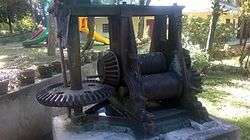
The old system of milling sugar cane used to produce sugar, called "intosan". Although the railway was originally to move coal, it was soon used too to move sugar cane to the docks.
Gun industry
Danao City was well known for its gun industry. The industry started around 1905–1906.[7] When World War II came, the Danao gunsmiths went underground, joined the guerrilla movement or were inducted into the USAFFE. Their main task was to re-chamber the Japanese Arisaka rifles to fit the US .30 caliber round or to keep the original Japanese rifle in good service.
The industry went on, still underground. In the 1960s, the term paltik was given to the homemade (and illegal) guns. In the early 1990s the industry was legalized by the government, with the creation of two organizations of local gunsmiths. The organization now left with proper permit is Workers League of Danao Multi-purpose Cooperative (World MPC), in Dungguan, Danao City.[8]
World MPC was incorporated on October 1994 with twenty-five initial members. In November 1996 it was given license to manufacture handguns from caliber .22 to .45 by the Philippine National Police (PNP). The organization had been a potent group in working for the legalization of gun-making industry in the country with the aim to upgrade the technology and skills of gun makers, to provide job security and additional revenue for the government. The gun-making industry in Danao was pioneered using brass or copper as materials. The Chairman of World MPC was in charge of the compliance of the requirements of the Firearms Explosives Security Service Agency and Guards Supervisory Section (FESSAGES) until his death in 2010 after which World MPC itself was then shutdown for non-compliance of FESSAGES policies.
21st century
Mitsumi
In Sabang, Mitsumi is one of the largest employers in northern Cebu.[9]
Holiday industry
Tourism is still at its infancy. All along the eastern seaboard of Cebu there are plenty of family-owned resorts. They generally have no facilities; that part of the coast has no beach, and the water is not clean to swim.
There are a few good resorts, such as El Salvador in Sabang, which are large enough to hold conferences during the week, weddings at the weekend. They can bring in large amounts of income into the local economy.
In 2017 Danao hosted the Xterra Off-road Triathlon. This was held on Coco Palms resort.[10][11]
Metro Cebu Expressway
"Work for the ₱50 billion, 74-kilometre (46 mi) Metro Cebu Expressway, will start next year (2018). It will connect Naga City in the south to Danao City in the north."[12]
Gallery
 City hall
City hall Father of Danao City
Father of Danao City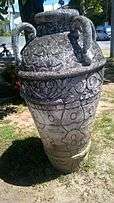 Roadside ornament
Roadside ornament Danao City market
Danao City market Danao City Public Market
Danao City Public Market
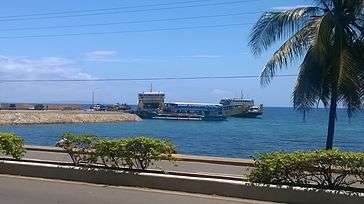 Port for ferries to Camotes and Leyte
Port for ferries to Camotes and Leyte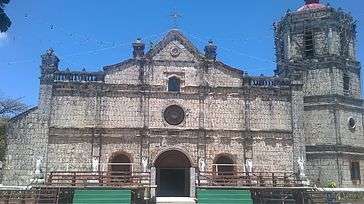 Sto Tomas de Villanueva church
Sto Tomas de Villanueva church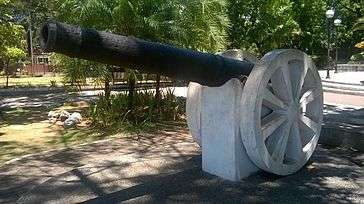 Old cannon with a more recent setting
Old cannon with a more recent setting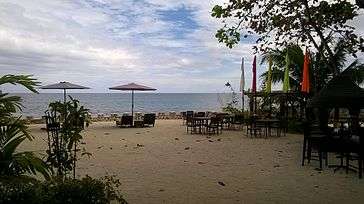 El Salvador resort, Sabang
El Salvador resort, Sabang
References
- ↑ "City". Quezon City, Philippines: Department of the Interior and Local Government. Retrieved 30 May 2013.
- ↑ "Province: Cebu". PSGC Interactive. Quezon City, Philippines: Philippine Statistics Authority. Retrieved 12 November 2016.
- 1 2 3 4 Census of Population (2015). "Region VII (Central Visayas)". Total Population by Province, City, Municipality and Barangay. PSA. Retrieved 20 June 2016.
- ↑ Sun–Star 2005.
- 1 2 Census of Population and Housing (2010). "Region VII (Central Visayas)". Total Population by Province, City, Municipality and Barangay. NSO. Retrieved 29 June 2016.
- ↑ Censuses of Population (1903–2007). "Region VII (Central Visayas)". Table 1. Population Enumerated in Various Censuses by Province/Highly Urbanized City: 1903 to 2007. NSO.
- ↑ Rama 2007.
- ↑ Sun–Star 2004.
- ↑ Mitsumi Electric Co, Ltd. - Cebu Mitsumi, Inc
- ↑ "Xterra Danao". Cebu. 23 April 2017.
- ↑ "Weiss, Wasle win XTERRA Danao". 26 April 2017.
- ↑ The Freeman 2017.
Sources
- Rama, Karlon N. (24 April 2007). "Boboy and Danao's thunder things". Archived from the original on 14 October 2008.
- Sun–Star, Oscar C. Pineda (20 January 2004). "Danao's gunmakers seek government aid". Archived from the original on 7 February 2004.
- Sun–Star (8 October 2005). "RDC enlarges Metro Cebu". Archived from the original on 30 September 2007.
- The Freeman, Erica Jean Palmera (15 May 2014). "The old Cebu Railway". Archived from the original on 19 May 2014.
- The Freeman, Mitchelle L. Palaubsanon (4 May 2017). "Construction of P50B road starts next year". Archived from the original on 20 May 2017.
External links
| Wikimedia Commons has media related to Danao. |

- Danao City Community Website
- Danao Association USA, Inc.

